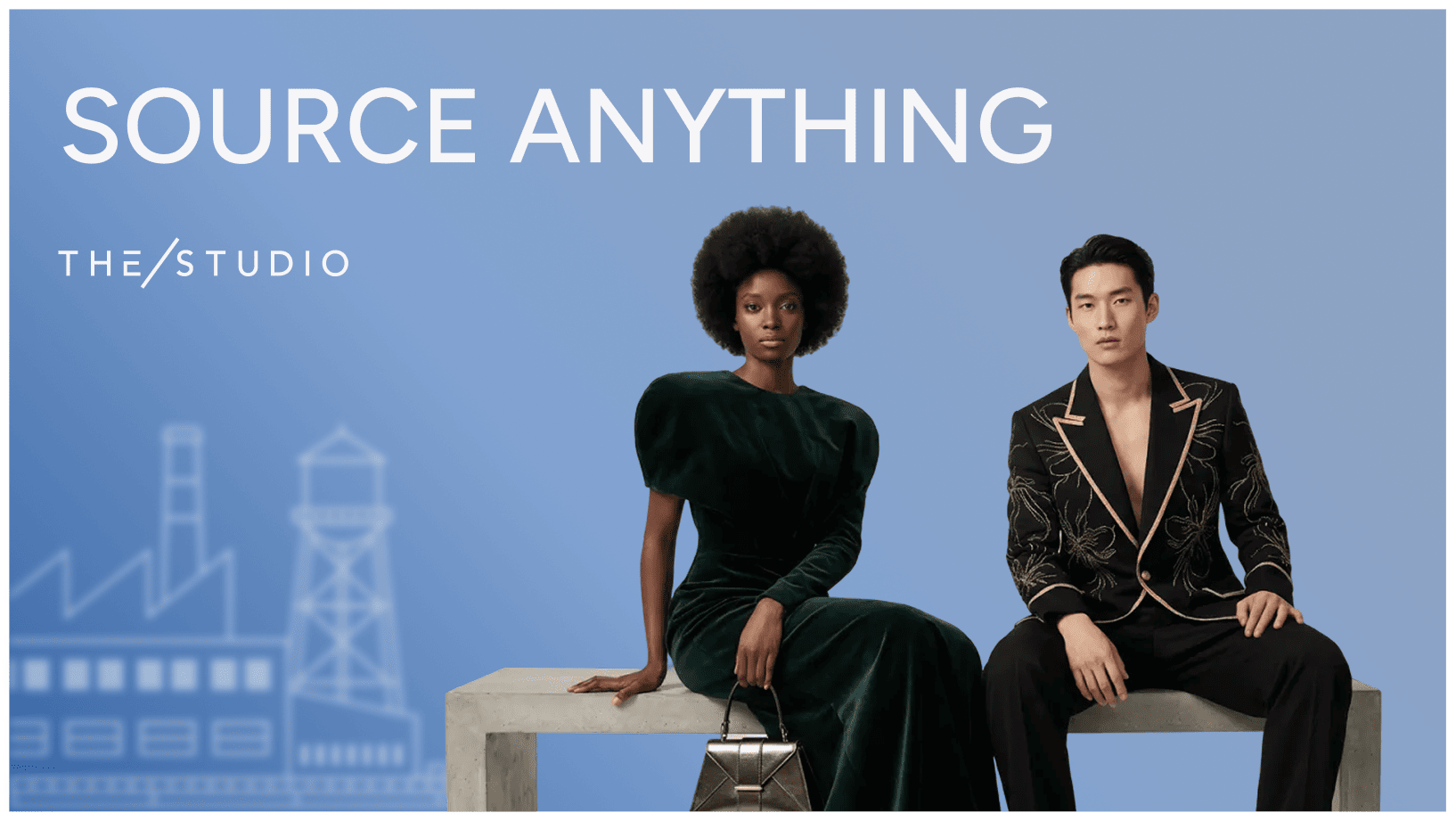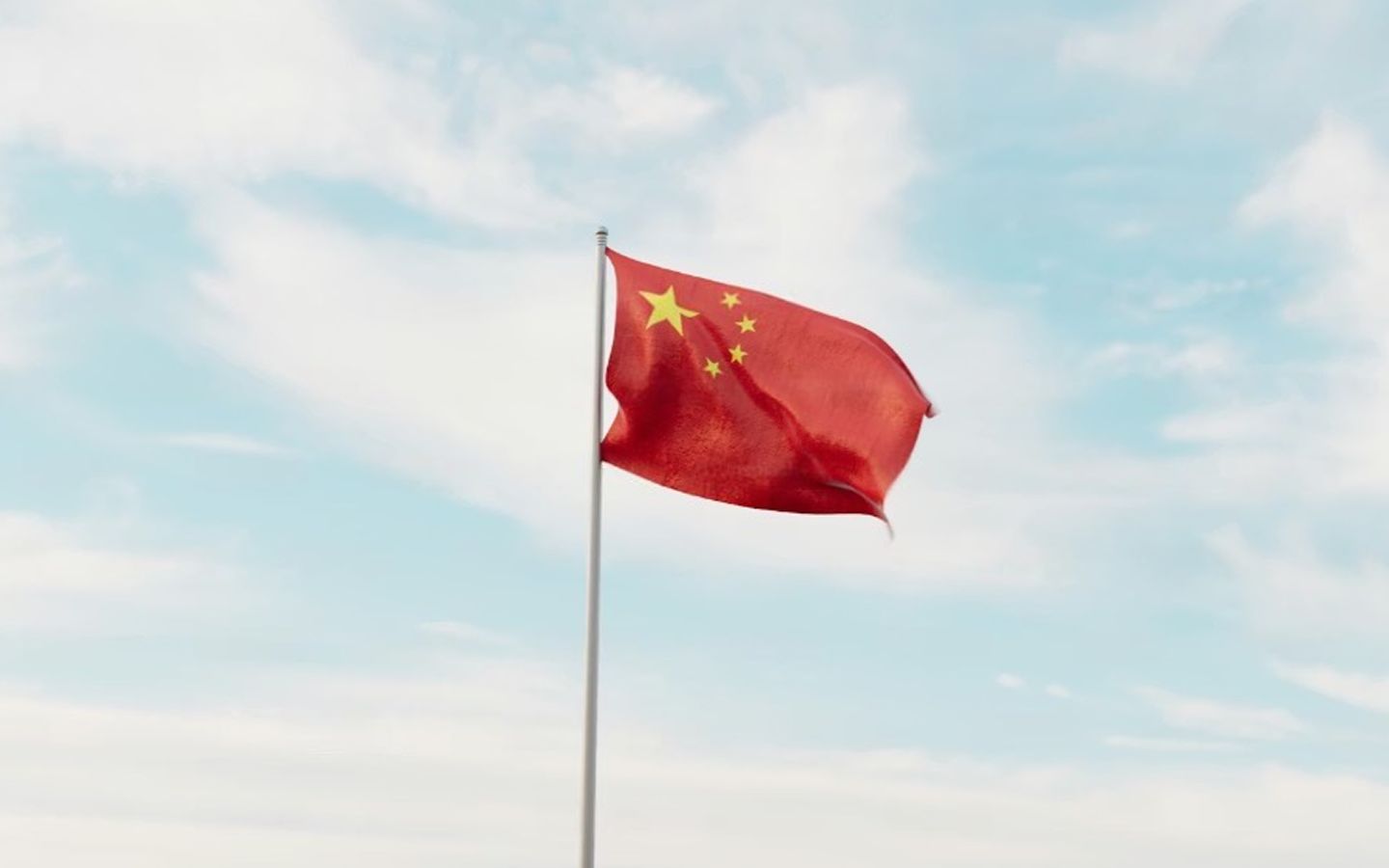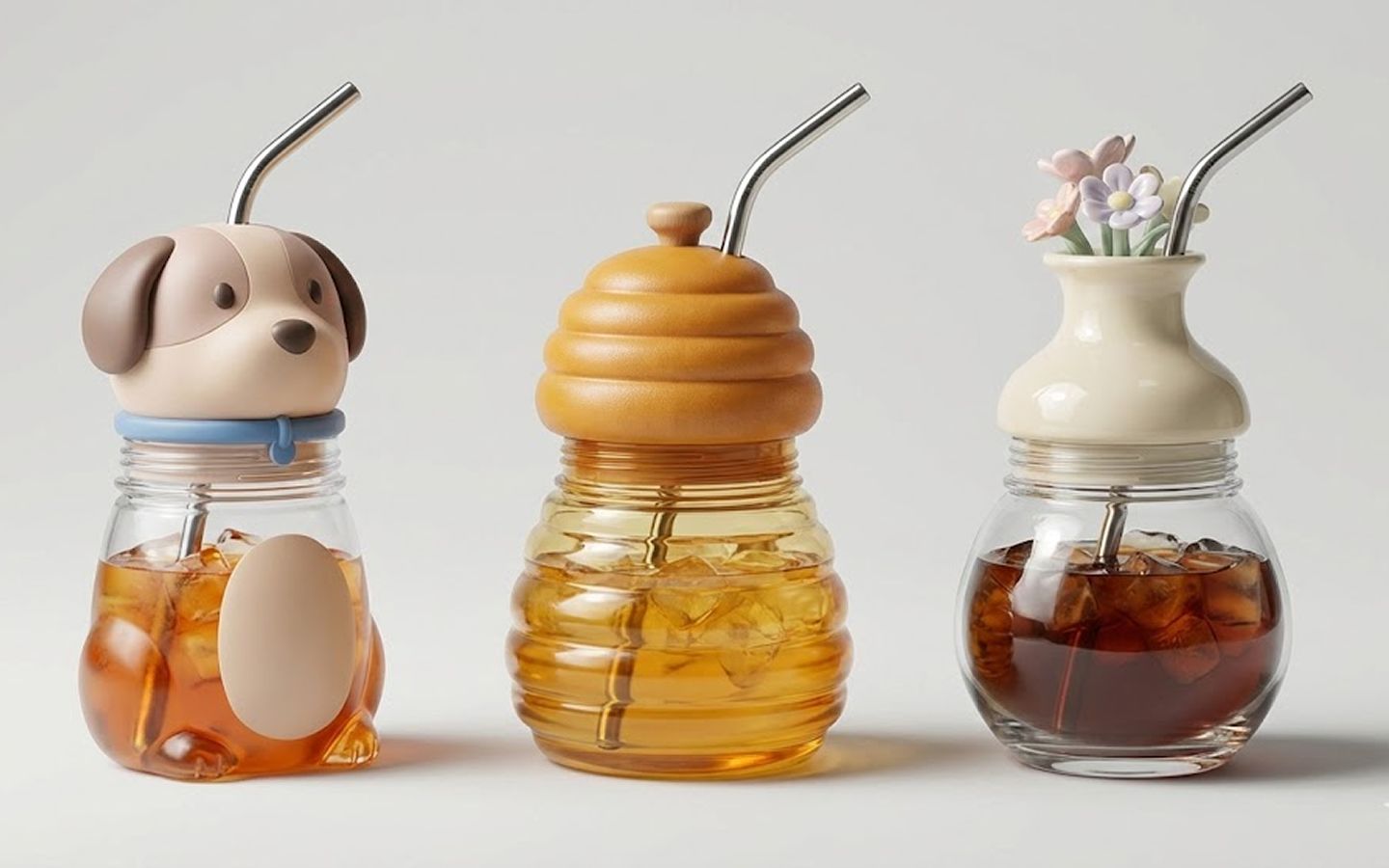What D2C brands can learn from Labubu mania
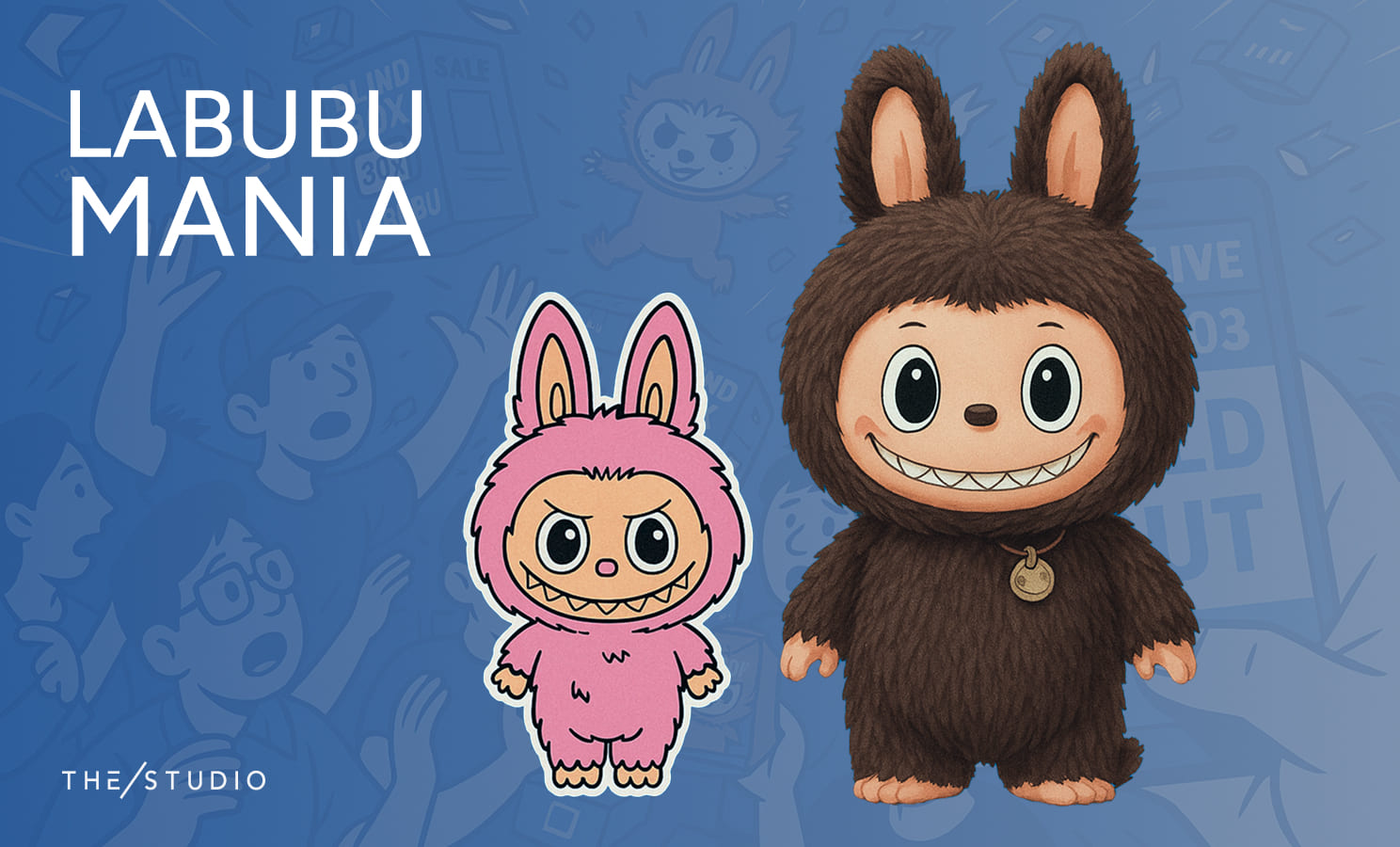
Labubu dolls have taken the world by storm, emerging as a viral collectible craze that’s equal parts fashion statement and what is essentially a toy with a cult following. These mischievous, elf-like plush monsters, with their pointy ears and devilish grins, are selling out within seconds of release and can be seen dangling from the handbags of A-list celebrities across the board.
In this guide, we’ll explore what made Pop Mart’s Labubu dolls so successful, whether this strategy could work for your brand, how to approach designing your own collectible characters and how to navigate the manufacturing process.
The goal? To help your brand create not just merchandise, but to become a lifestyle brand built around wholly unique products.
The rise of Labubu: from niche art to global phenomenon
Labubu began as the brainchild of Hong Kong-born artist Kasing Lung, who created a fairytale universe called “The Monsters" in a trilogy of picture books inspired by Nordic mythology. The most beloved character was Labubu, a "small monster with high, pointed ears and serrated teeth," who is "mischievous" yet kind-hearted (though often accidentally causing chaos).
Lung first introduced Labubu figurines in 2015 through art-toy producer How2Work, cultivating a niche following in the designer toy community.
The breakthrough
Labubu’s breakout moment came in 2019, when Lung partnered with Beijing-based Pop Mart, a then-rising toy retailer known for its blind-box collectibles. Pop Mart helped transform Labubu from an indie art toy into a mainstream must-have. By 2025, over 300 different Labubu toys have been released in various sizes, from $15 pocket vinyls to giant limited editions costing nearly $900. There’s even a 4-foot Labubu that sold for over $150,000!
A global phenomenon
Pop Mart’s clever retail strategy, limited releases ("drops"), blind-box surprises, and global distribution amplified Labubu into a worldwide phenomenon. In the first half of 2024 alone, Pop Mart’s The Monsters line (which centers on Labubu) generated a staggering $870 million in sales. The company’s annual revenue more than doubled in 2024, topping $1.8 billion, largely on the back of the Labubu craze.
The success of Labubu has made Pop Mart’s founder, Wang Ning, the fifth wealthiest person in the world under the age of 40. This meteoric rise of Labubu was neither overnight nor accidental; it’s a masterclass in blending pop culture, storytelling, and savvy marketing. Let’s break down the elements behind Labubu’s success and what any brand can take away from it.
How Labubu dolls became so successful
Pop Mart releases Labubus in tightly controlled drops that sell out almost instantly. Online releases happen Thursday nights (around 9 - 10 PM Eastern Time in the US), with in-store restocks on Friday mornings. The supply is purposely limited, often just a few hundred units, and fans know they need to act literally within seconds of an announcement. Pop Mart’s website frequently crashes from heavy traffic, and lines form outside retail stores during surprise restocks.
Engineered scarcity and “drop” culture
This engineered scarcity fuels mass FOMO in potential buyers. Collectors treat each new Labubu drop like an online scavenger hunt on steroids, sharing tips in social media chat groups and refreshing pages to snag one before they’re gone.
The unpredictability of blind boxes, where buyers never know which variant they can get their hands on until they open it, adds extra thrills and a heightened collectible factor. As the “New York Magazine” puts it, the appeal lies in the “hard-to-explain cuteness” and the “surprise and scarcity”.
Labubu blurs the line between toys and fashion and taps into our desire for what is elusive to others.
Cultural hype and celebrity endorsement
Nothing propels a trend like celebrity validation. Labubu’s popularity exploded in mid-2024 after BLACKPINK’s Lisa was spotted with a Labubu plush charm on her bag. That single Instagram post sparked an instant frenzy across East and Southeast Asia.
Soon after, other global icons followed, one by one falling under the spell of Labubu. Kim Kardashian. Rihanna. David Beckham. NBA stars. Super models at the Milan Fashion Week. Each new sighting fueled the craze, turning this impishly plush creature into a bona fide status symbol.
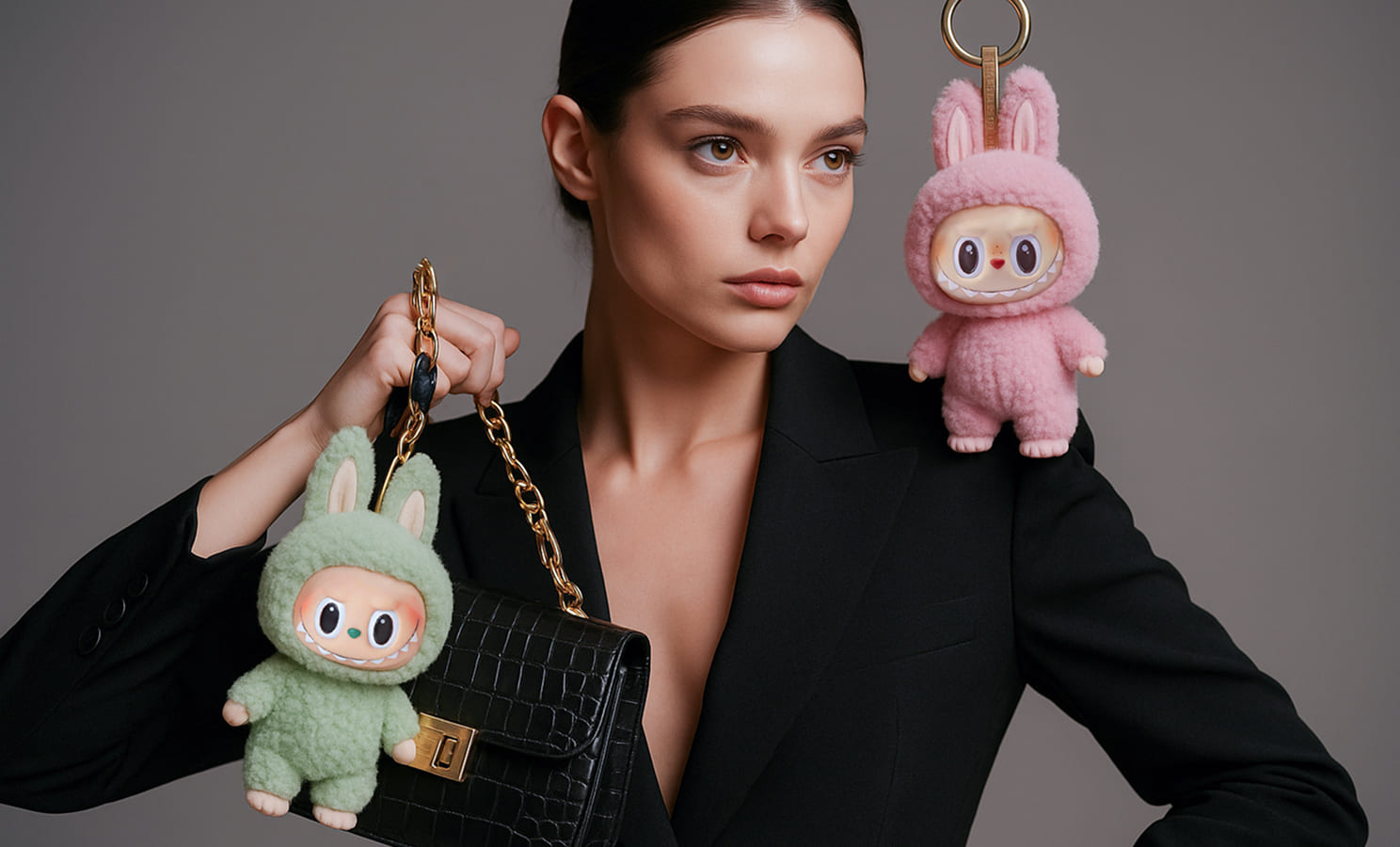
“It’s one of the rarest and most exclusive ones you can get,” said one retailer about a Labubu type flaunted by the chart-topping British rapper Central Cee on his Hermès manbag, noting that resale prices easily soared into four figures for the most sought-after variants.
This kind of organic influencer marketing, gifting products to celebrities who align with your brand ethos, can significantly amplify desirability. Labubu’s fanbase now spans from Hollywood to high fashion and the music industry in between, encouraging everyday consumers to want a piece of the trend.
Unique design with storytelling
At first glance, Labubu’s look is deliberately offbeat, “ugly but huggable,” as one journalist put it. With wide round eyes, a wide, roguish grin chock-full of razor-sharp teeth, and wild fluffy hair, Labubu’s “ugly-cute” aesthetic is oddly irresistible, aligning with a broader trend towards quirky, unconventional aesthetics in fashion and toys alike.
Crucially, the character comes with built-in lore. Labubu is not just a random sheeplike doll thingy, but a fleshed-out character from Lung’s complex and storied world, a sly but well-meaning fuzzy imp from a Norse-inspired fairyland. Every series of Labubu figures has a central theme or narrative, whether it is Labubu dressed as One Piece characters or a winter-themed Labubu x Coca-Cola crossover.
This clear storytelling and consistent design make the product line feel cohesive and collectible. Fans are not just buying a trinket, they are buying into a shared universe.
For D2C brands, the lesson is clear: whatever merch or collectible you create should tie into a compelling story or identity that your customers already love about your brand.
Crossover appeal: fashion accessory meets Toy
Part of Labubu’s genius is that it straddles multiple categories. It is a toy, but also a stylish accessory and a Warholian piece of pop art décor. This has helped Labubu appeal to a wide range of demographics, from teenage streetwear fans to adult high-end fashion aficionados.
Interest in men’s luxury handbags has been rising approximately 7 percent a year, and Labubu capitalized on that trend by offering men a playful way to personalize otherwise serious designer totes.
In today’s “kidult” culture, toys are not just for children; they are ultra-chic collectibles for all genders and ages. Labubu’s success reflects a broader consumer desire for nostalgia, comfort and playfulness in uncertain times. From Gen Z to Millennials, people are embracing whimsical items as “affordable luxuries”.
By creating a sense of community and exclusivity around the product, through trading groups, display cases and limited-edition hunts, and by riding social media-fueled hype, Pop Mart turned Labubu into more than a simple toy. It is a full-blown cultural sensation.
Can this approach work for your brand?
Witnessing Labubu’s astronomic success, you might wonder whether your brand could launch its own collectible figure or doll line. The answer is yes, if done smartly. Collectibles and designer toys now appeal to nearly every demographic, and consumers are open to brands expanding into lifestyle merchandise that complements their main products.
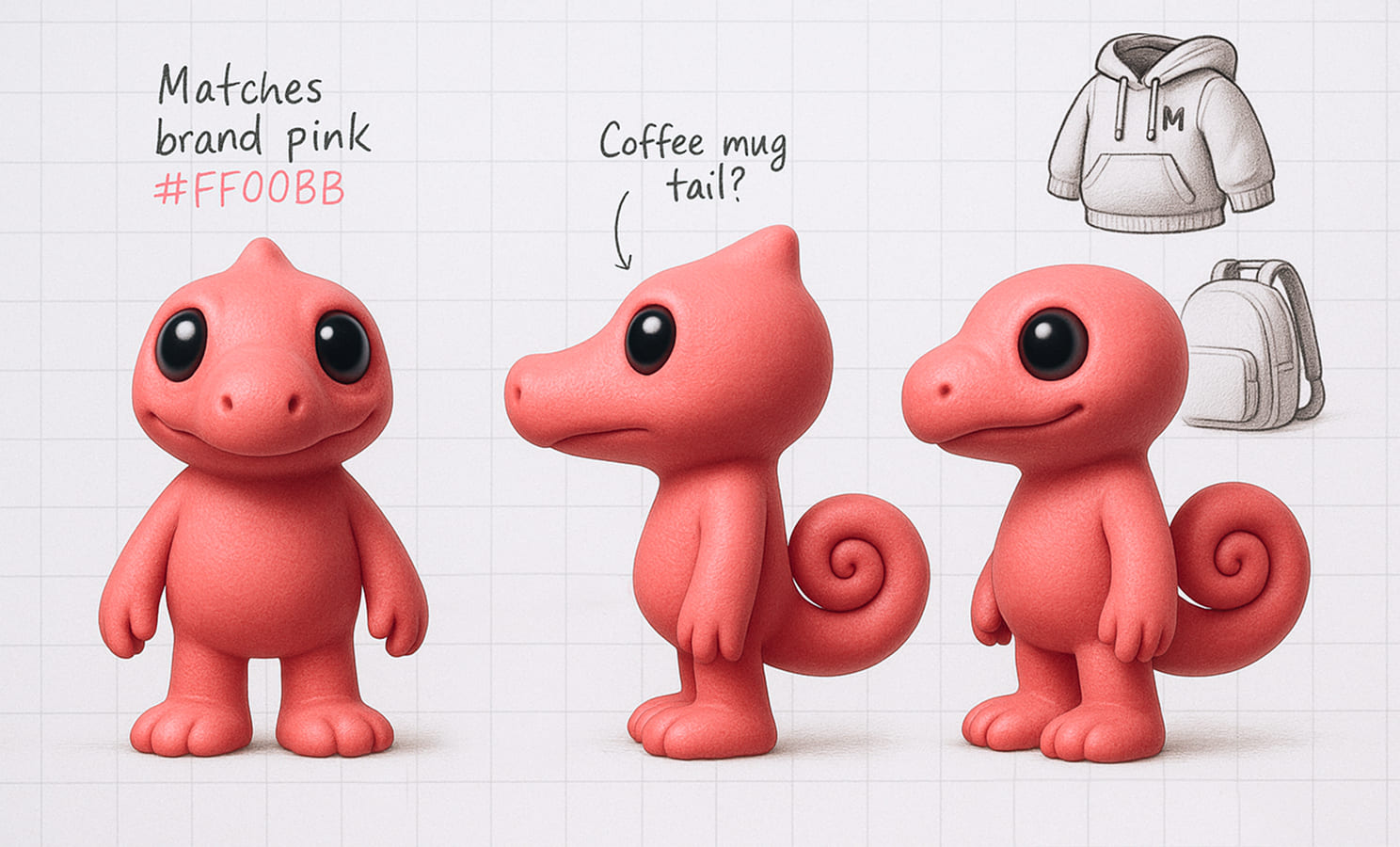
Becoming part of your customers’ lifestyle
The goal is to become an integral part of your customers’ lifestyle and identity. A coffee shop could go beyond serving lattes, offering branded merchandise that customers take home. A streetwear label might extend its attitude to skateboards, basketballs or collectible art toys. The key is to expand in ways that fit your audience and brand story.
For example, a trendy café could create a cute mascot figurine that customers can buy as a desk buddy, fitting the cozy coffeehouse vibe. Selling camping axes would probably miss the mark unless your target customer actually loves glamping and axes.
Authenticity and relevance matter
Labubu’s playbook can inspire brands of all kinds. Even restaurants and hospitality businesses now create merch to strengthen their community. The crucial part is ensuring authenticity and relevance. Your collectible character or figurine series should resonate with your brand values and customer interests.
- A cosmetics brand might create funky makeup-themed characters.
- A sports team could design mascot mini-figures for fans.
- An outdoor apparel brand might launch cute wilderness creatures that double as keychain flashlights.
The possibilities are truly endless. The key is that the collectible in question should feel like a natural extension of your brand’s universe, not just a random product with your logo on it.
Manage supply and scarcity carefully
Labubu proved that carefully managing supply and hype can trigger a genuine frenzy. For a first attempt, small production runs help test the concept with minimal risk while scarcity drives buzz. A win-win endeavor for any brand.
It is easier than ever to start, with 3D modeling and overseas manufacturing branded custom toys for just a few thousand dollars.
Collectibles as marketing vehicles
A well-executed collectible can become a powerful marketing vehicle in its own right. Labubu’s presence on social media, with fans posting unboxing videos or outfit photos featuring the doll, effectively turned customers into fully-fledged brand ambassadors for Pop Mart. If your brand’s figurine catches on, you might see customers proudly sharing it on Instagram or TikTok, spreading your brand message in a fun and totally organic way. It’s merch, it’s marketing and if managed well, it can even become a profitable revenue stream.
Designing your own collectible characters
So you’ve decided to create figurines or dolls that capture your brand’s vibe. The design phase is critical, because no matter the hype (or what the item actually is), the product must look appealing and feel meaningful. Here is how to approach it.
Craft a story and character lineup
Start by defining the theme. Can you evolve an existing mascot or invent new characters that reflect your brand? Storytelling is key, even a short paragraph of lore for each character helps.
For example, Pop Mart’s Labubu series features not just Labubu but also friends like Mokoko and Spooky, each with distinct personalities yet all part of The Monsters world. Brainstorm a small cast, perhaps three to six characters, that fit a coherent theme. This could be “coffee shop critters” for a café, “sneakerhead monsters” for a footwear brand, “cosmic fairies” for a cosmetics line, or “soldiers” for a veterans-focused brand. The theme should align with your brand identity.
For inspiration, look at recent kidult collectibles like Squishmallows, Sonny Angel, Smiski, and Jellycat plushies, all the way back to the legendary Beanie Babies; arguably the first internet-era hot toy or fad craze. These products combine charm, collectibility and clear themes, exactly the qualities you want your own product to achieve. Study what makes them genuinely resonate.
Hire a skilled illustrator or designer
To bring your ideas to life, you’ll need a designer experienced in character or toy design (that is if that’s not a hidden skill of yours). If you have an in-house designer, you’re golden. Otherwise, look for freelance illustrators on Behance, Dribbble, ArtStation, Upwork, or Fiverr. Choose someone whose style matches your aesthetic and check their portfolio for character design experience.
AI tools like Midjourney, DALL·E, Stable Diffusion, or Runway ML can help with early concept ideation, but a human illustrator should refine and finalize designs to ensure intentional detail and good translation to physical form.
Remember to design with a three-dimensional form in mind. Front, back and side profiles or simple 3D sketches will help your manufacturer later in the process.
Consistency and brand fit
Make sure each character includes subtle nods to your brand. This could involve using your color palette, logos or symbols in outfits or accessories that reference your product. The connection can be obvious or subtle, but it should be there.
For example, if you are a coffee brand, maybe your cat mascot holds a coffee cup. If you are a tech brand making robot toys, maybe their names or features reference your products. When customers see the figure, they should immediately associate it with your brand’s world.
At the same time, avoid overcrowding designs with branding. The collectible should stand alone as an appealing object, even to those unfamiliar with your company.
Once you have sketches or renders you like, gather feedback from trusted customers, friends or even your social media audience. Ensure the characters evoke the feelings you intend, such as fun, luxury or nostalgia, and tweak as needed.When the design phase is complete, it is time for the next step: turning these designs into actual physical products.
Manufacturing & sourcing: bringing your dolls to life
Producing a physical collectible figure can seem daunting, but thousands of indie creators and brands have done it successfully by working with the right manufacturing partners. Your search will almost certainly lead you to China.
China is the global epicenter of toy manufacturing, especially for molded plastic or vinyl figurines. Factories there have decades of expertise, specialized machinery, and economies of scale that keep costs lower than elsewhere. Even after tariffs and shipping, China typically remains the most cost-effective and capable option.
The advantages of manufacturing in China
Other countries like Vietnam, Thailand, or Mexico can produce toys too, but expect to pay more and face higher minimum order quantities. For context, moving production out of China can raise costs by 10 to 40 percent in Southeast Asia, over 100 percent in the US, and more than 300 percent in Japan. Europe lacks a strong supply chain for this kind of manufacturing.
China also offers a major advantage in infrastructure. Many factories there can produce not just the figure itself but also related clothing, accessories, and packaging, making it easier to handle everything in one place. Turnaround times tend to be faster too.
Now, within the realm of toy manufacturing, you have to choose which production method and material to use for your figurines. The main methods for collectible figures are vinyl rotocasting, PVC injection molding, hand-cast resin, or 3D printing. Each comes with pros and cons:
Rotocast vinyl
This is the method used for Labubu and most art toys. Liquid vinyl is poured into a mold and rotated to coat the inside evenly. Vinyl figures feel slightly soft and squeezable with clean surfaces and vibrant paintability, ideal for that signature "designer toy" aesthetic. The downside is cost: molds run $3,000 to $6,000 and minimum orders typically start at 500 units. Expect unit costs of around $6 to $12 for a 3-inch figure, putting total costs at roughly $5,000 to $9,000 before packaging. Vinyl is the sweet spot for brands anticipating a few hundred units of demand, yielding professional-quality toys at a moderate upfront investment.
Injection molded PVC
PVC is used for mass-market action figures and high-end collectibles. It allows finer detail and produces solid, durable figures. Unit costs can be low at scale ($3 to $8 each), but mold tooling is expensive ($5,000 to $12,000 or more) and minimum orders often start at 1,000 units. For most small D2C brands, vinyl achieves nearly the same visual quality and makes more economic sense unless you need ultra-fine detail or plan to produce thousands.
Hand-cast resin
Resin figurines are handmade in small batches by pouring resin into silicone molds, allowing runs as small as 10 to 50 units. Mold costs are low (a few hundred dollars), and resin captures detail well with a dense, high-quality feel. The downside is brittleness and higher unit costs ($15 to $30 per figure) due to manual labor. Resin is excellent for limited editions, artist proofs, or testing demand before scaling up with vinyl.
3D printed resin
High-resolution 3D printing lets you produce figurines on demand with virtually no upfront tooling costs, provided you have a 3D design file. However, printing is slow and expensive per unit ($20 to $50+ each) with significant post-processing. Quality can vary unless using very high-end printers. 3D printing is best for prototyping or ultra-limited runs under 50 units. If you see significant demand, you would transition to vinyl or PVC for larger production.
To summarize: vinyl rotocast is the best option for most brand collectible projects, resin is ideal for small-run testing or artist editions, PVC makes sense for larger scale production, and 3D printing is great for prototyping or very small runs.
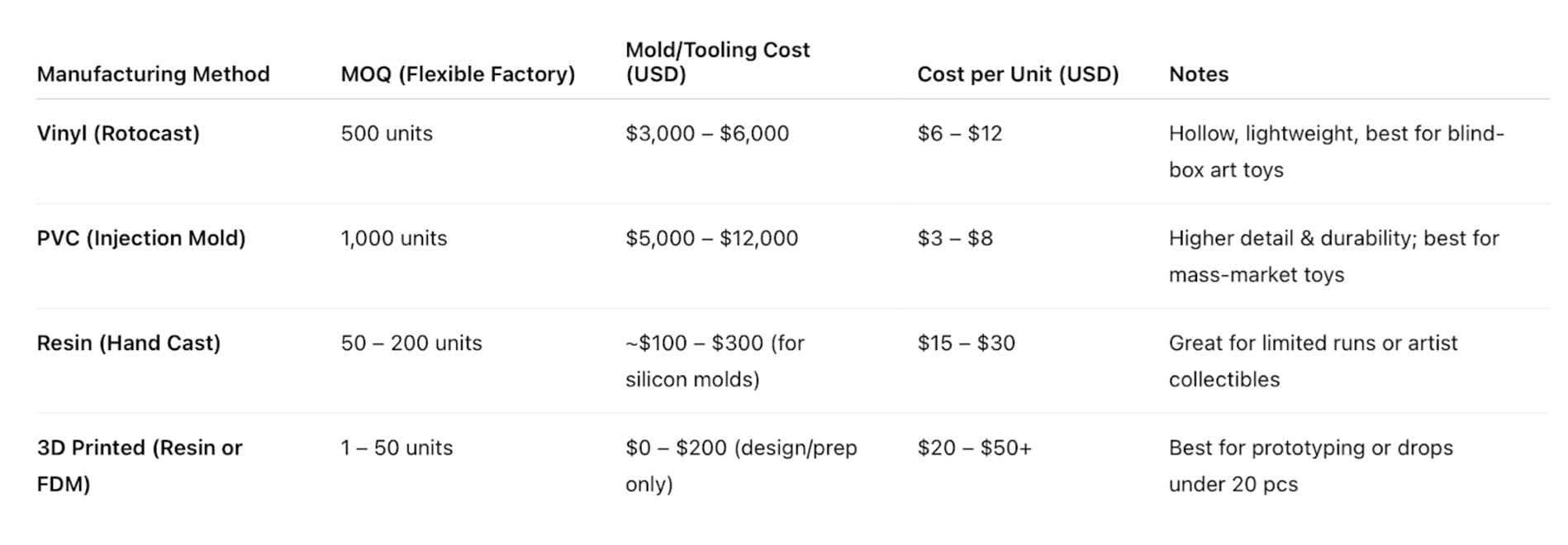
Apparel and accessories manufacturing
Making tiny clothes or accessories is its own niche. You will likely need a specialized supplier, such as factories that produce plush toys or doll accessories. Many factories in China have experience sewing doll outfits and printing miniature graphics.
Costs are reasonable: a simple outfit might cost $1 to $3.50 per piece, while more elaborate designs with premium materials, embroidery, rhinestones, or detailed tailoring could range from $5 to $10.
When designing apparel, ensure it is easy to put on the figurine, using features like elastic waists or Velcro backings. Well-made accessories can significantly boost the perceived value of your collectible.
Packaging and kitting
Blind-box collectibles typically follow a familiar format: each figure is sealed in a foil or poly bag and packed in a small, attractively printed cardboard box, with identical packaging so the specific figure remains a mystery. Labubu uses this model: you buy a box and only discover the variant inside when you open it.
For your brand, you can choose whether to use blind packaging or not. Blind packaging adds a fun surprise element but means customers might not get the exact character they want unless they buy multiples or trade. It works best when you have a lineup of characters and want to encourage collecting them all. Alternatively, you can package each variant distinctly, and using the same packaging for all variants can reduce costs.
Custom packaging is relatively inexpensive and feasible at low minimums, around 500 to 1,000 units. Ballpark costs: about $0.70 to $1.20 for a full-color printed box, $0.15 to $0.30 for an inner bag, and $0.05 to $0.10 for extras like a paper insert or card. If you plan to position your figures as premium products, investing in quality packaging is worthwhile, as it is the customer’s first impression.
Another compelling opportunity is the growing third-party market for protective cases made specifically for Labubu dolls.
Offering a custom display case as a free gift can be a powerful way to add perceived value, elevate the customer experience and build loyalty. It also subconsciously reinforces that what you’ve created is worth protecting, highly collectible and of course, special.
This is a PET (Polyethylene Terephthalate) protective case, thermoformed using vacuum forming to ensure a precise fit around the plush figure. It's similar to traditional action figure packaging but thicker and custom-shaped.
Minimum order quantities typically start at 1,000 units, though a THE/STUDIO Premium factory may accommodate lower MOQs. Mold costs range from $300 to $700, and unit pricing falls between $0.25 and $0.60 depending on order volume, dimensions, and other specifications.
This is an acrylic wood case with a wood or synthetic wood base. The good thing about this type of case is that you don’t need to pay any mold fees, and you can probably source a generic one and perhaps emboss the name of your brand either on the acrylic or wood.
Now, you have a couple of approaches in terms of how to kit your product.
One-stop shop manufacturer
Some figurine factories can handle everything: the figure, clothing, and packaging, delivering a finished, boxed product. This is convenient, but they often mark up outsourced parts by 10 to 50 percent. They may not always choose the best or cheapest subcontractors but have established relationships and can manage the process for you. If you are short on time or experience, this turnkey approach can reduce headaches.
DIY sourcing and assembly
The alternative is to manage the supply chain yourself, sourcing each component from specialists. This means working with separate suppliers for figures, apparel, and packaging, then coordinating final assembly. This can save costs and provide greater control over quality.
A smart tactic is to ship all components to your packaging supplier and have them handle final kitting, including packing, sealing, and labeling. Many packaging vendors offer this service and may include it at little or no extra charge if negotiated well. One tip: finalize your box price first, then ask if they can also handle packing as part of the deal. Be sure to provide clear instructions or a sample showing exactly how you want each unit packed.
Whichever route you choose, good communication is key. Share your vision and long-term plans with suppliers. They are often more flexible on minimums, pricing, and timelines if they see growth potential. For example, if their minimum is 1,000 units and you need 500, explain this is a pilot for a larger product line and they may accommodate or suggest a compromise.
Timeline, logistics and costs
Let’s talk about timing and cost, the nitty gritty of getting your figures made and delivered. Once you have final designs and choose manufacturers, budget about 3.5 to 5 months if shipping by sea, or 2.5 to 3.5 months if shipping by air.
Sampling and tooling (1 to 2 months)
The factory will create prototypes or molds. For vinyl or PVC, cutting a metal mold takes 4 to 6 weeks. They will produce samples for your approval. For resin or 3D print, they simply make sample casts or prints. Allow time for shipping samples, feedback, and any revisions. Packaging proofing can happen in parallel. Do not rush this stage; catching issues early is crucial.
Mass production (about 1 month)
Once samples are approved, the factory begins production. This includes molding, painting, and assembling figures, while apparel and packaging are also produced. Production itself may take a few weeks, but one month accounts for quality checks and coordination.
Assembly and kitting (1 to 2 weeks)
If consolidating parts from multiple suppliers, allow time for receiving all items, assembling the packages, and preparing cartons for export.
Shipping (2 to 6 weeks)
Air freight from China to North America takes roughly 2 weeks door-to-door. Sea freight is slower: about 3 to 5 weeks port-to-port, plus customs and trucking, so 6 weeks or more in total.
Because these products are small and high-margin, shipping by air is often worth it. The typical cost difference is about $2.50 per unit by air versus $1.90 by sea, depending on weight, but art toys are light. Paying a bit more per unit to reduce delivery time by a month or more allows you to start selling sooner. Many brands ship exclusively by air to enable fast drops and quick restocks.
If you have tight timelines, communicate that upfront. Factories on THE/STUDIO’s platform understand the need for speed and can help meet your schedule, for example by using 3D printing for prototypes or running two production shifts. A rush fee may apply, but it can be worth it for launches tied to holidays or events.
Throughout production, stay in close touch with your manufacturers. Ask for progress photos. THE/STUDIO’s platform provides updates and images throughout the process, and its manufacturers can also help arrange logistics and ensure your items clear customs without hassle.
Customs duties
This product should be classified under HTS/HS code 9503.00.41 (“Plush toys, representing non‑human characters”). As of July 2025, imports are subject to:
Previously, many toys entered the USA duty-free, but Trump-era tariffs raised the baseline from 0% to 10%, with China facing an additional 20%, totaling 30%.
Tariff policies are frequently updated. For the most current rates, refer to our customs-duty tool or the latest HTS data.
Crunching the numbers: profit potential
Ultimately, is this venture going to make money? Let’s do a quick hypothetical math exercise to see how the costs add up and what pricing makes sense. Suppose you decide on a vinyl run of 500 units of your brand’s collectible doll:
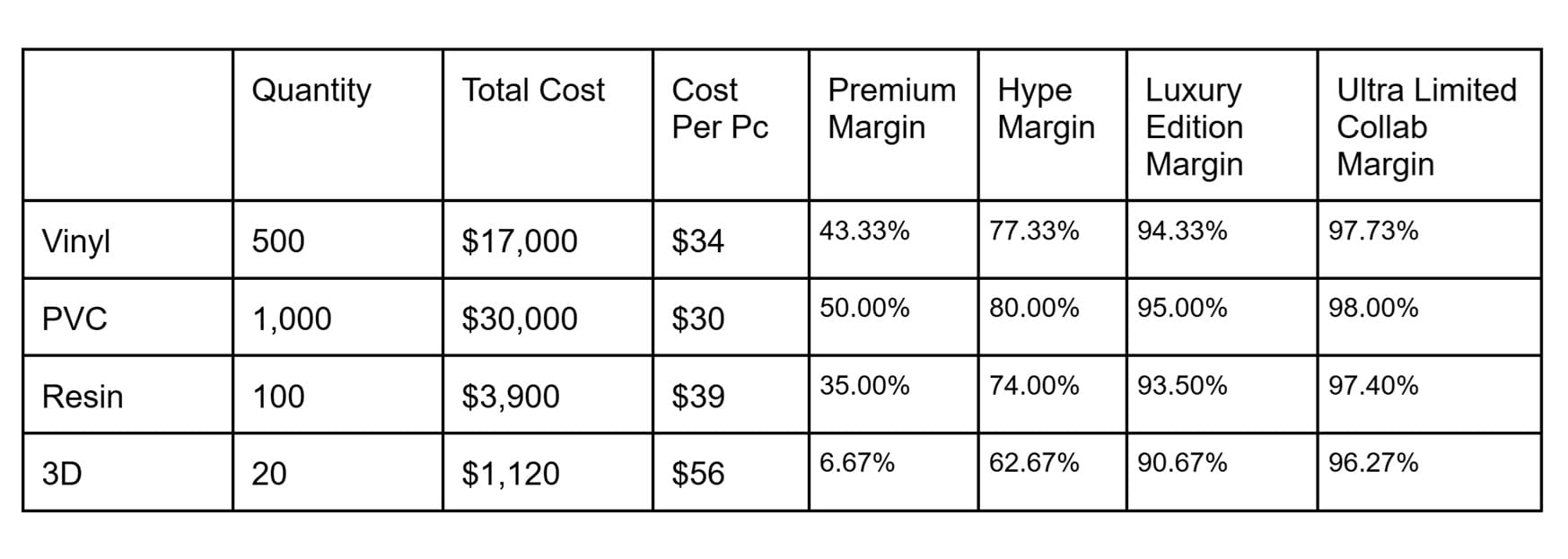
This is a hypothetical example, and many variables can impact the final outcome. However, in this sheet, we've outlined a reasonable quantity you might order using each manufacturing method, along with the total estimated cost. This includes toy production, mold fees, clothing and packaging, shipping, and customs duties.
It’s important to note that mold fees are one-time costs. If you reorder, those fees are removed, meaning your profit margins improve significantly for vinyl and PVC production, where molds can account for 25% to 30% of initial costs.
We’ve used the higher end of the potential retail price to demonstrate what's possible. For direct-to-consumer (D2C) sales, we aim for a gross margin of around 67%. Based on that target, only vinyl or PVC production can achieve this, and only after the first run. However, if you position the item as a limited-edition, hype-driven streetwear drop, strong margins are achievable across all manufacturing methods.
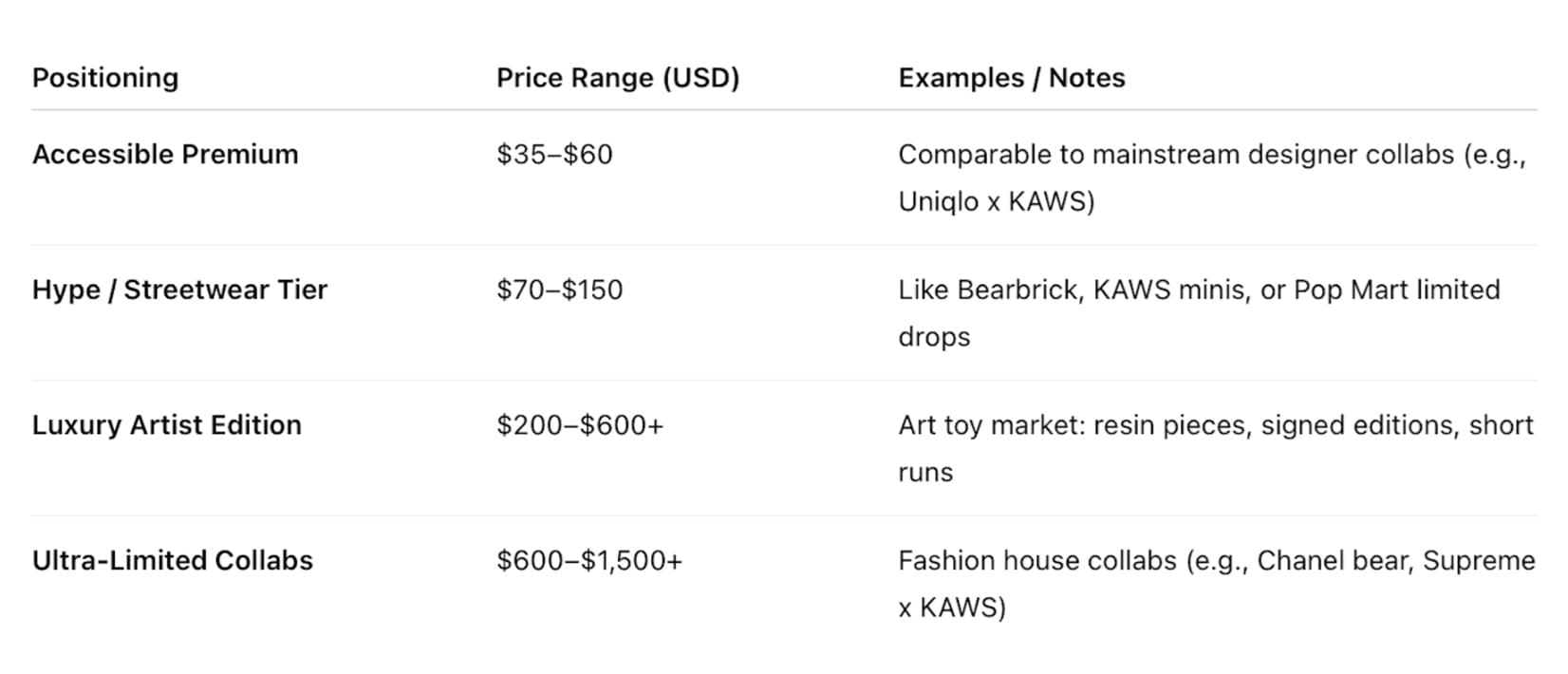
There’s also strategic value in using these figures as unique, memorable gifts for customers or employees, something your competitors likely won’t offer.
The best part? For just $1,120 with 3D printing or $3,900 with resin production, you can test whether this concept resonates with your audience. Post it on Instagram, launch a limited drop, and gauge demand before scaling.
Final thoughts
Labubu’s wild success shows that consumers are hungry for exciting but very tangible ways to connect with brands and culture. By creating your own collectible dolls or figurines, you are essentially giving your fans a piece of your brand they can physically unbox, hold and enjoy; a tiny ambassador of your world that fits in their palm or perches neatly on their desk.
Approach this adventure with lighthearted creativity but clever and thoughtful planning. Make it authentic to your brand, focus on great or even pioneering design, and execute the manufacturing smartly. Who knows, your brand’s mascot could be the next character flooding social feeds, turning up in celebrity selfies, or selling out at 9 PM on a Thursday night drop.
In an era where hype and heart both matter, a strategy like this just might hit the sweet spot, transforming a simple toy into a marketing powerhouse, a community builder, and a coveted product line.
Good luck and get designing! After all, from Hello Kitty to the Michelin Man, some of the world’s most iconic characters started as simple mascots and ended up as all-encompassing cultural phenomena.
You never know what will capture the zeitgeist next.


